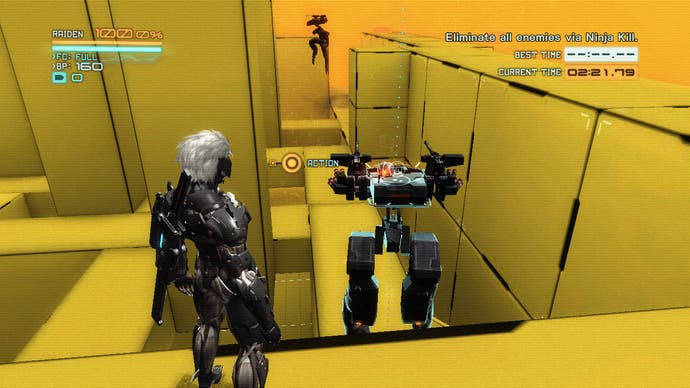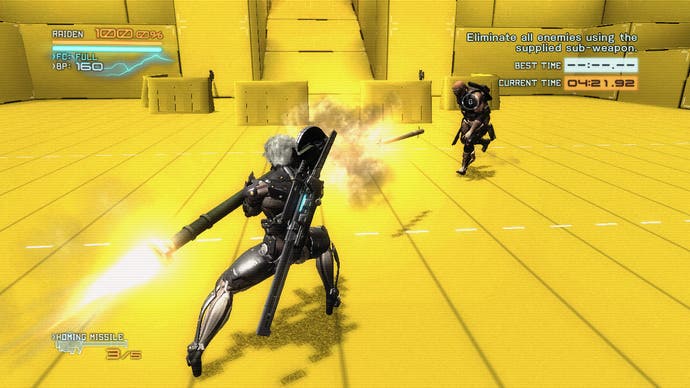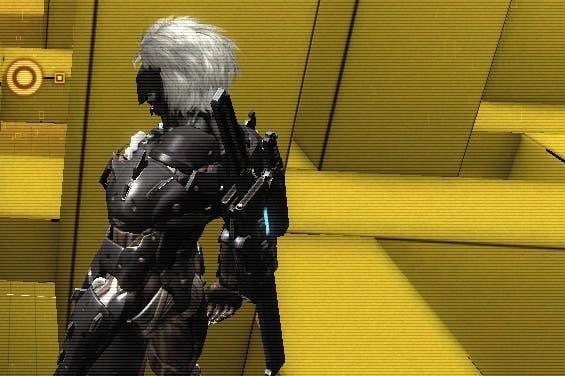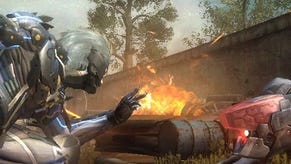Metal Gear Rising: VR Missions review
Knives out.
To begin with, Metal Gear's VR missions are little more than a lab-coated sort of field training. You're transported to some abstract, detail-less room and clinically led through the basics away from the noise and distraction of the game world. Each mission isolates a different aspect of the game (sneaking, sprinting, slicing and so on) and, through sparse instructions and with flickering sound effects, presents a challenge to lead you through apprenticeship towards mastery. By creating a safe place in which to fail and grading your performance, Metal Gear's VR missions act as a crucible in which to hone your technique and gain the necessary muscle memory for use in the 'real' game world, with its concrete and cardboard, its nooks and shadows.
But after the basics are learned, Metal Gear's designers have historically used the VR Missions as a space to let their creative imagination run more freely - either introducing humour, parody or exaggeration to play with the game mechanics in ways that the storyline disallows, or to present more stringent and specific tests of your abilities.
As such, this particular set of 30 punchy VR missions for Metal Gear Rising (the first of three planned downloadable add-ons for the game) reveals something of creator Platinum Game's true personality and spirit. It contrasts in interesting ways with the 300 VR missions originally created by Konami for Metal Gear Solid in 1999.
Konami's formative suite of VR missions was well ordered, categorised by type. There were missions that focused fully upon stealth; missions designed to test your ability with a specific weapons; and an array of inventive 'special' vignettes offering timed battles with boss characters, or even a set of murder mystery scenarios in which you had to identify the killer. There was abundant humour, but delivered within narrow and precise constraints.

No such thoughtful organisation for Platinum's set, which jumbles together ideas with a scattershot attitude that bespeaks the developer's wilder character. That's not to say that there isn't plenty of variety on display. One moment you'll be manning a mounted turret as the ninja Raiden, machine-gunning down helicopters and pop-up cardboard cut-outs of soldiers against the clock. The next, you'll assume the role of one of the game's three-armed Dwarf Gekkos, comically sprinting across a busy road in a top-down approximation of Frogger. But Platinum is not a game developer known for its restraint, and there's little rhyme or reason to the organisation of missions and almost no sense that you're being led along a balanced learning curve.
The absence of a learning curve is perhaps the most persistent niggle in this add-on for all but the most accomplished S-rank players. After the first 10 missions, the difficulty scales with brutal immediacy. Each mission is graded according to the amount of time taken to complete (rarely more than a few minutes), but the criteria for acquiring the top ranking on each mission is prohibitively high.
Platinum asks a great deal more of players than Konami ever did. While something has been lost in the general levelling of challenge across video games in recent years, Platinum perhaps plunges too far the other way here. There are few things so dispiriting as finally completing a VR mission to find that you didn't even manage to pass the bronze medal threshold for your performance.
Still, the ego-kicking Platinum's designers dole out does little to deaden the creative fizz of many of these missions. In one you must guide a Dwarf Gekko along perilously thin walkways to reach the goal - it's reminiscent of the later Super Monkey Ball stages. In another, you must defeat waves of super soldiers by luring them into bomb clusters positioned around the level, manipulating their AI path-finding routines to bring about their destruction.

One stand-out later mission removes Raiden's swords altogether and switches the viewpoint to that of a side-scrolling brawler, requiring you to parry incoming attacks and kick away grenades. These highlights mostly compensate for the more pedestrian missions in which you must merely hunt out targets in labyrinthine warrens against the clock, or challenges in which you must time grenade throws to explode distant moving targets. These stages lack creative energy and are, in general terms, weaker than the least inspired Konami effort from a decade ago.
This first piece of DLC for Platinum's game also suffers from some complicating external factors. In America, it's limited to PS3 owners, although they enjoy the benefit of receiving it for free until early April. Across Europe, both Xbox 360 and PS3 owners have access to the add-on, although it comes at a (small) cost. Most frustratingly, the DLC's grand prize - a powerful wooden sword dubbed the Snake Soul, which commentates on the player's actions in the chattering voice of a hyperactive Solid Snake - is only included in the Japanese release. Whether the cost of localisation was too great or whether it's indicative of a split with Snake's American voice actor David Hayter is unclear, but the result is the feeling that this is a joke that lost not only its punch line, but also its very existence in translation.
An add-on of varied success then, best enjoyed by players with enough talent to master its tall challenge, or by those who can afford to invest a considerable degree of time and effort in order to memorise each mission's intricacies. Boisterous, unruly, exuberant and showy, these VR missions reflect the character of their maker - both for better and for worse.









